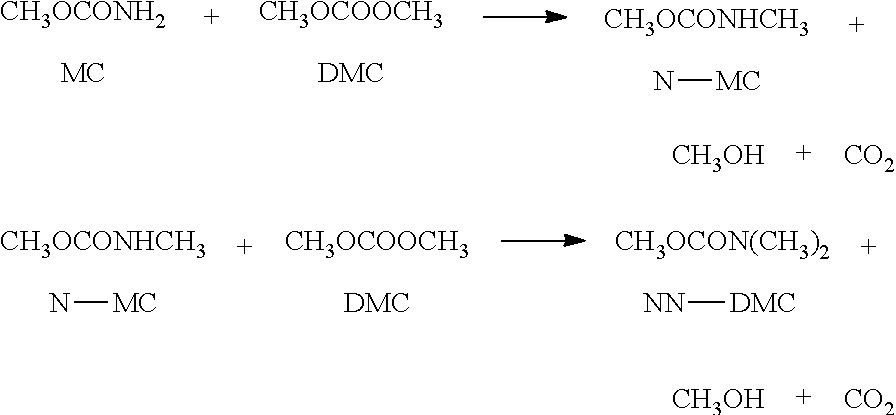Method for preparing dialkyl carbonate
a dialkyl carbonate and carbonate technology, applied in the preparation of carbonic/haloformic acid esters, chemistry apparatus and processes, organic chemistry, etc., can solve the problems of limiting the large-scale production of dmc and its applications, toxic carbon monoxide as a raw material, and low conversion rate, and achieves high raw material concentration, excellent stability, and increased reaction rate
- Summary
- Abstract
- Description
- Claims
- Application Information
AI Technical Summary
Benefits of technology
Problems solved by technology
Method used
Image
Examples
example 1
Preparation of DMC at Atmospheric Pressure and 180 ° C.
[0043]A reaction system such as a distillation system equipped with a magnetic stirrer capable of stirring the mixture was used. A mantle type heater with temperature indicator and controller was used and was equipped with a condenser, an ammonia absorber, and a metering pump. Moreover, the reactor was connected to a metering pump capably of injecting alkyl alcohol at a constant flow rate into a reaction solution containing the ionic liquid and urea. A preheat coil capable of vaporizing the injected alkyl alcohol was installed in the reactor such that the alkyl alcohol was dispersed in the vapor phase to the reaction. When the reaction system was established, 100.08 g of ionic liquid [choline][NTf2] synthesized in the above Synthesis Example and 7.502 g (0.125 mol) of urea were placed in a 250 ml three-necked round flask reactor and mixed with 2.003 g of zinc oxide used as a catalyst. Nitrogen was fed into the reactor to replac...
example 1-1
[0047]DMC was prepared in the same manner as in Example 1, except that methyl carbamate was used instead of urea.
examples 2 to 9
Preparation of DMC at Atmospheric Pressure and 180 ° C.
[0048]DMC was prepared in the same manner as in Example 1, except that CaO, MgO, PbO, and hydrotalcite [Mg5Al(OH)12(CO3)0.5.4H2O] and an impregnated catalyst containing 20% by weight of ZnO and 80% by weight of TiO2 were used as catalysts instead of ZnO catalyst. The yields and the selectivity according to the reaction times of the prepared DMC were shown in the following table 1:
TABLE 1DMC AnalysisAfter 2.5 hours ofAfter 6.5 hours ofAfter 10.5 hours ofReactionReactionReactionSelectivitySelectivitySelectivityExamplesCatalystsYield (%)(%)Yield (%)(%)Yield (%)(%)Example 1ZnO23.189.426.394.938.897.4ExampleZnO9.333.621.169.028.183.51-1Example 2CaO17.680.622.685.428.391.3Example 3MgO26.484.130.889.839.994.5Example 4PbO11.160.837.991.653.295.5Example 5Y2O313.161.420.375.329.485.4Example 6La2O36.153.77.650.612.658.1Example 7Hydrotalcite(1)34.388.646.595.339.485.5Example 8Hydrotalcite(2)16.482.724.090.925.294.2Example 920 wt %11.968.52...
PUM
| Property | Measurement | Unit |
|---|---|---|
| molar ratio | aaaaa | aaaaa |
| temperature | aaaaa | aaaaa |
| flow rate | aaaaa | aaaaa |
Abstract
Description
Claims
Application Information
 Login to View More
Login to View More - R&D
- Intellectual Property
- Life Sciences
- Materials
- Tech Scout
- Unparalleled Data Quality
- Higher Quality Content
- 60% Fewer Hallucinations
Browse by: Latest US Patents, China's latest patents, Technical Efficacy Thesaurus, Application Domain, Technology Topic, Popular Technical Reports.
© 2025 PatSnap. All rights reserved.Legal|Privacy policy|Modern Slavery Act Transparency Statement|Sitemap|About US| Contact US: help@patsnap.com



